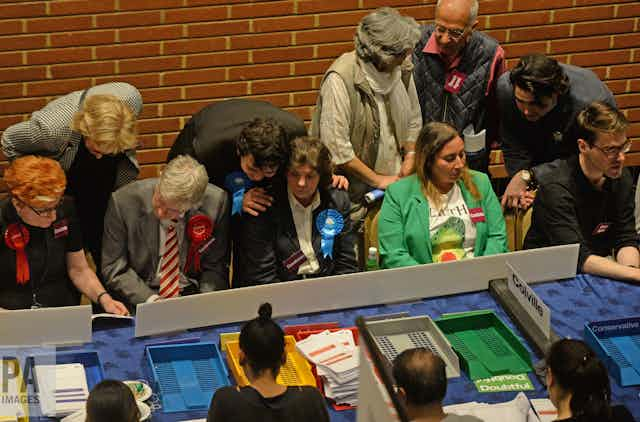The local elections across England on May 3 were the first major test of public opinion since prime minister Theresa May lost the Conservatives’ parliamentary majority in 2017’s snap election and returned at the head of a minority government. As then, multiple localised contests defy any single national narrative. As then, the emerging picture is a virtual stalemate between the Conservatives and Labour.
Voters across large swaths of England cast their ballots this year. All the seats in London’s 32 boroughs were up for grabs, as were all the seats in four metropolitan boroughs, seven non-metropolitan districts and one unitary authority. A proportion of seats in 106 other local authorities were also being contested, not to mention five local mayoralities and the new metro mayor for the Sheffield City Region combined authority. If it sounds confusing, it is. Local democracy in England is a kaleidoscopic mess.
Britain has become used to hyper-dramatic elections in recent years. The 2018 contest, by contrast, was much more low key. It was also a mixed night for both the Conservatives and Labour. Overall the Tories have trod water, with no significant changes in their total number of council seats and, at the time of writing, no change in the total number of councils they control. Labour has increased slightly its tally of councillors, but without translating these gains into control of additional councils.

This aggregate-level continuity conceals a great deal of local upheaval. For instance, the Tories lost Trafford in the North West, with Labour now the largest party in a hung council, but they gained control of both Peterborough and Basildon councils. Labour gained Plymouth from the Conservatives but lost control of both Derby and Nuneaton and Bedworth councils. Labour also picked up seats across London without gaining control of councils.
It was a much clearer picture for the Liberal Democrats. The party has so far picked up around 40 councillors across England and won control of Richmond-upon-Thames council. An electoral pact there between the party and the Greens helped to deprive the Tories of 28 seats, with 24 of them going to the Liberal Democrats.
It was also a much clearer picture for the United Kingdom Independence Party. The party lost ground everywhere, haemorrhaging all but a handful of seats. UKIP has exerted a huge influence over British politics in the past four years, but it now seems in a post-Brexit death spiral.
The expectation game
The actual results, of course, are only part of the story. Expectations also matter. The Conservatives won last year’s general election but fell far short of the anticipated landslide victory. Labour lost last year’s general election but deprived the Tories of their majority. By exceeding unfathomably low expectations, Corbyn emerged as the clear winner in the eyes of his supporters.
Labour has clearly not won the expectations game this year. There was huge optimism that grassroots campaigning would again drive a Labour surge. In the event, momentum from the 2017 general election was not sustained. The party failed to take control of many of the London boroughs that it had to win, including Barnet, Wandsworth and Kensington and Chelsea, the scene of the tragic Grenfell fire. The party also failed to take control of Swindon council in Wiltshire. Corbyn visited the area five times during the campaign, seemingly to no avail.
The Conservatives have arguably won the expectation game. A few months ago, the party was reportedly bracing itself for extensive losses, including a potential wipe-out in London. Neither outcome materialised. The Tories have certainly lost ground in areas that supported Remain in the 2016 Brexit referendum, but this tendency is consistent with the party’s performance in the general election. Crucially, the Tories remain a strong presence in English local government. And they have not been wiped out in London.

What will be the effect of this on national party politics? For the government, and especially for May, there will almost certainly be huge relief. The party will be disappointed at its losses, but will draw comfort from its gains and especially from the knowledge that, despite its recent problems over the Windrush scandal and its ongoing civil war over Brexit, voters have not punished it. May’s authority could even be bolstered by the outcome of these elections. Ministers can return to the job of hammering out an agreed party line on Brexit.
For Labour, there are more questions to be asked. Despite facing a hopelessly divided government, despite claiming the scalps of several ministers in recent months, despite the huge increase in its membership, and despite the local activism, the opposition has failed to make massive inroads. Corbyn and his new-old Labour party undoubtedly inspires huge confidence among some supporters. But there are no signs yet that anyone outside his base views him and as his party as a viable alternative to the Tories.
For the time being, many voters seem to be reserving judgement on the government. They also seem to be reserving judgement on the opposition. Much will probably hinge on the terms of any final Brexit deal. Assuming the next general election is in 2022, there is still much to play for.

